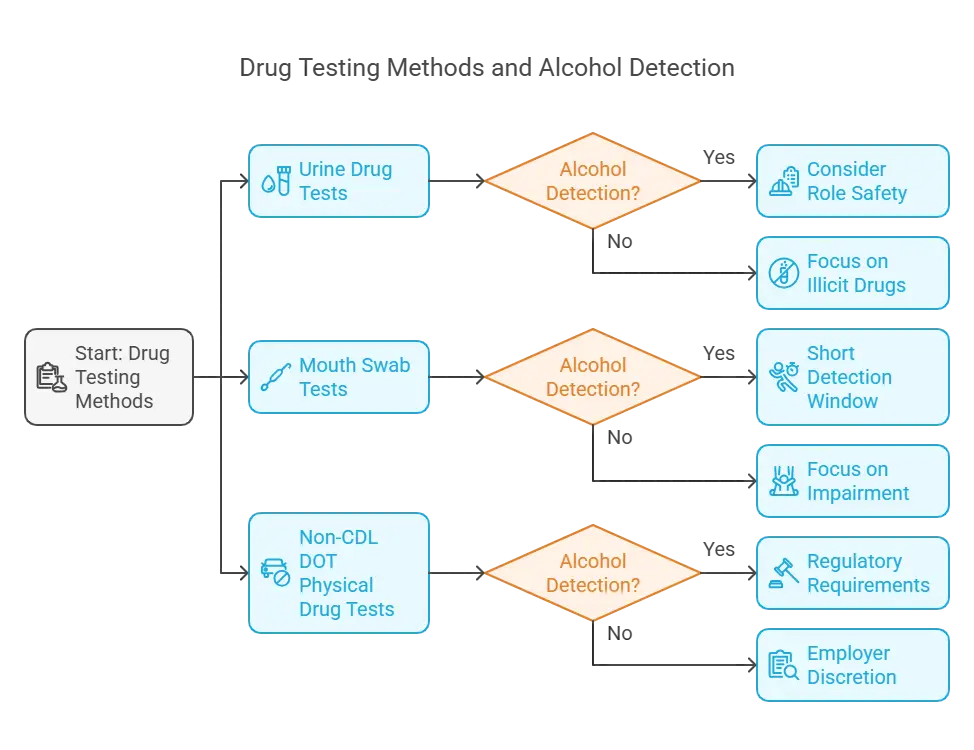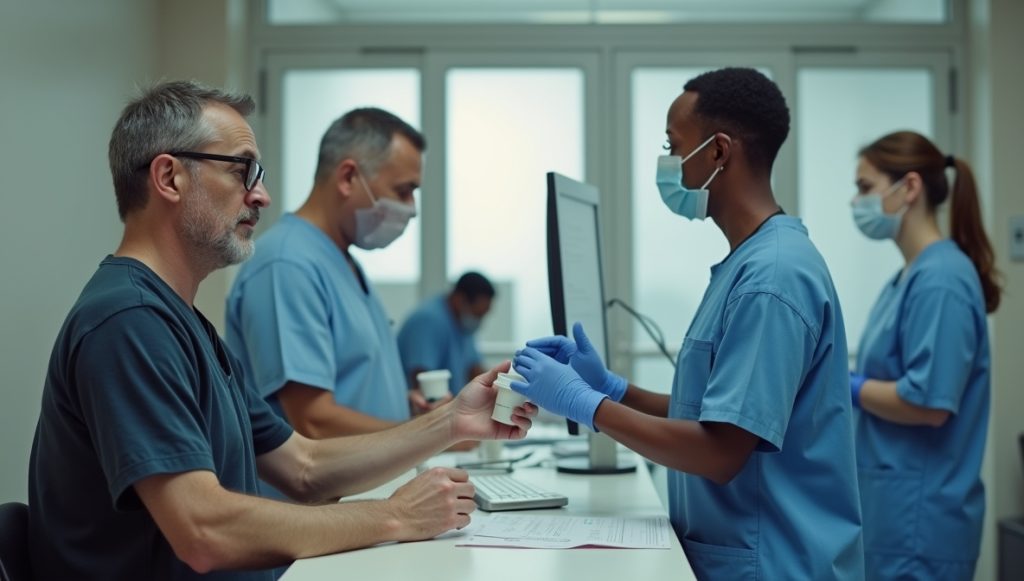Does your pre-employment drug screen test for alcohol? You might think the answer is straightforward, but it's a bit more nuanced than you may expect. This guide will demystify pre-employment drug screens and their relationship with alcohol testing.
Drug screenings are an essential part of many hiring processes, ensuring companies maintain workplace safety and compliance. For those in industries like healthcare, transportation, and technology, understanding what these tests involve can be crucial. Business owners, HR professionals, and job seekers alike should know what to expect.
Key Takeaways
- Pre-employment drug screens are crucial for workplace safety and legal compliance, particularly in high-risk fields like transportation and healthcare.
- While standard drug tests typically focus on illicit drugs, alcohol testing is not always included, except in certain safety-sensitive industries.
- Urine and mouth swab tests are common methods, with alcohol detection sometimes added for roles where safety is paramount.
- Misconceptions, such as topical THC use affecting test results, highlight the importance of understanding testing limits and processes.
- Employers must tailor their drug testing policies to align with legal standards and industry requirements, while job seekers benefit from being informed and prepared.
Introduction
Picture this: You're sitting across from a potential employer, confident in your skills, when the conversation shifts to pre-employment drug screenings. It's a routine part of the hiring process, but the implications can be far-reaching, especially in fields like transportation, healthcare, and tech. These screenings are more than a checkbox—they're a critical safeguard for workplace safety and legal compliance.
So here's the big question: "Do pre-employment drug screens test for alcohol?" The answer isn't as black-and-white as you might think. While many drug screenings focus solely on illicit drugs, some industries demand a closer look at alcohol use due to the inherent risks involved. Understanding the nuances of these screens is vital, whether you're the one hiring or the one hoping to be hired.
In this guide, we'll unravel the complexities surrounding drug and alcohol testing. For employers, this knowledge ensures you're ticking all the legal boxes and protecting your team. For prospective employees, it's about knowing what lies ahead and being prepared. Let's dive in, break down the myths, and get you ready for whatever comes next.

What Are Pre-Employment Drug Screens?
Pre-employment drug screens are tests companies use to identify traces of drugs in a potential employee's system before hiring them. These screenings serve as a precautionary measure to ensure that employees align with workplace standards for safety and conduct. The goal is straightforward: identify and manage risk.
There are several methods employers can use to conduct these tests. The most common types include:
- Urine Tests: Often the go-to method, urine tests are cost-effective and can detect a range of substances. They are widely used due to their broad detection capabilities and relative ease of administration.
- Mouth Swabs: This method involves collecting saliva to identify the presence of drugs. It's less invasive and can be done on-site with quick results, making it a popular choice for many employers.
- Non-CDL DOT Physical Drug Tests: This variety applies to certain positions that require Department of Transportation (DOT) compliant testing, although it might not be as comprehensive as for commercial driver’s licenses (CDL).
The main reasons for these screenings are threefold:
Workplace Safety: By performing drug tests, companies aim to maintain a safe environment where employees operate at their best. Particularly in industries like healthcare and transportation, one slip-up can have severe consequences.
Legal Compliance: Many industries are bound by law to conduct these tests. It's not just about keeping employees safe but also about adhering to regulations that demand stringent oversight.
Productivity: Drug use can impact productivity and decision-making. By screening potential employees, companies strive to avoid potential pitfalls that could interfere with their operations.
In essence, pre-employment drug screens are not just about policing potential hires; they're a proactive tool to foster a safe, compliant, and productive workplace.
EXPERT INSIGHT: Is it normal that pre-employment drug screenings can raise more questions than answers? Wearing my HR hat who handles background screening, to me, yes, especially when it comes to alcohol testing. Transparency in the process can help improve the screening experience for both the candidate and the organization. Overall, having clear communication about the tests helps avoid surprises. It fosters confidence during the employment process and helps cultivate a workplace with trust at its core. - Charm Paz, CHRP
Do Pre-Employment Drug Screens Test for Alcohol?
When it comes to pre-employment drug screens, the focus is typically on illicit drugs like marijuana, cocaine, and opioids. Alcohol, however, often doesn't make the cut in standard screenings. Most employers are more concerned with illegal substances that could pose a safety risk or affect productivity on the job.
Typical Practice
For many employers, drug screens do not automatically include alcohol. The standard panel of drugs tested does not naturally incorporate alcohol detection due to its mode of processing in the body – it is metabolized and out of the blood relatively quickly and typically looked into under different contexts, like random workplace checks or reasonable suspicion tests.
Exceptions
There are notable exceptions, especially in industries where safety is paramount. Transportation and healthcare, for example, often go further. In these fields, the safety and well-being of others hinge on sober judgment. Consequently, alcohol testing can be a routine part of pre-employment screenings. Nurses, ambulance drivers, and pilots are likely to undergo more rigorous testing that leaves no stone unturned.
Regulatory Insights
Working within these guidelines ensures compliance with regulations like those from the U.S. Department of Labor (DOL). According to the DOL, there are no federal mandates requiring alcohol testing for pre-employment, but industries are free to implement standards that exceed the baseline, especially when safety is on the line. Employers should devise their policies with an eye towards both industry norms and legal prudence, laying the groundwork for a robust and compliant safety strategy.
Detailed Look into Drug Testing Methods
Urine Drug Tests
Urine drug tests are the most common method for pre-employment screening, but when it comes to alcohol detection, the story changes. Normally, these tests are designed to detect illicit substances, focusing more on drugs like THC, cocaine, opiates, and amphetamines. Alcohol, however, is typically not a primary focus unless the employer requests a specific alcohol screening. In the context of urine tests, ethanol metabolite testing can determine recent alcohol use, but it isn't standard practice unless precise reasons deem it necessary, such as roles that prioritize safety.
Financially, adding alcohol testing can bump up costs, which might deter businesses from including it in general screenings unless regulations mandate it. The additional price, although varying, generally makes the thoroughness of testing a consideration weighed against its purpose. Either way, understanding the dynamics of when alcohol pops up in these tests is crucial: it's not just about detecting presence but judging its relevance to job performance and safety.
Mouth Swab Tests
When you think of mouth swab tests, speed and convenience come to mind. They provide non-invasive and quick results, but does this apply to alcohol detection? While swabs primarily target drugs like THC and opioids, alcohol can be detected within a short window post-consumption—typically only up to 24 hours. This is ideal for assessing current impairment rather than historical use.
Mouth swabs, therefore, might serve industries requiring fast feedback on whether a candidate is fit for duty, particularly in positions where manual dexterity or operational tasks are critical. Their cost, usually lower than more comprehensive methods, can include alcohol testing upon request. As with any test, it's about customizing to fit the specific needs of the role.
Non-CDL DOT Physical Drug Tests
For Non-CDL DOT drug tests, the focus shifts. Here, the regulatory lens sharpens on ensuring a drug-free environment for roles that don't require a commercial driver's license but still operate under the Department of Transportation's umbrella. Though alcohol isn't always tested, exceptions exist.
The emphasis on safety often brings alcohol under scrutiny, particularly when roles cross into areas where concentration and precision can't be compromised. In these situations, regulatory initiatives might enforce alcohol screenings, merging with broader drug testing requirements. This makes understanding the context and clarity of specific mandates imperative for both employers and employees in comprehending what exactly is at stake with these tests.
Urine Drug Tests
Urine drug tests are the workhorses of pre-employment screening—straightforward, routine, and fairly economical. But do they check for alcohol? Typically, no. Standard urine drug tests prioritize illicit drugs over alcohol, focusing on substances like marijuana, cocaine, opiates, amphetamines, and PCP. That's not to say testing for alcohol via urine is impossible; it's just not common practice because alcohol metabolizes quickly.
In specific scenarios, especially for roles demanding high safety standards, employers might opt for comprehensive panels that include alcohol. The reason: liability and safety. It's rare but worth knowing. Not just cost plays into this choice, but purpose: why test for a substance generally not present in a typical work environment after a night’s sleep?
Cost considerations add another layer to the story. Basic urine tests are significantly cheaper than expanded ones that detect alcohol. When companies choose to spend on alcohol testing, it's a decision guided by necessity rather than standard procedure. Balancing budget with workplace safety and regulatory compliance is a dance every HR department knows well.
Mouth Swab Tests
Mouth swab tests, also known as saliva tests, are a popular choice for pre-employment drug screenings due to their ease of use and quick results. Unlike more invasive methods, a mouth swab is simple—just a quick swipe inside the cheek, and you’re done. But can these tests detect alcohol? In many cases, yes. They are capable of identifying alcohol presence, depending on the specifics of the test being used.
Swab tests detect substances that are used relatively recently, which makes them effective at catching alcohol consumption within a short timeframe, typically up to 24 hours. This brief detection window means mouth swabs are particularly relevant in industries where immediate impairment could pose risks, like transportation or healthcare. Consequently, these sectors might opt for saliva tests to include alcohol screening as a safety measure.
This immediacy can be both a benefit and a limitation. For industries keen on ensuring current sobriety, the speed and reliability of mouth swabs can be advantageous. However, if a broader history of substance use is needed, other methods like urine tests might be more appropriate. These swabs are cost-effective and can be administered easily, but employers need to tailor their testing strategy to suit their particular compliance and safety needs.
So, while not always standard for alcohol detection, mouth swab tests offer a valuable option for certain employers, especially those prioritizing safety in real-time. Understanding when and how to use these tests can help employers maintain a secure and productive workplace.
Non-CDL DOT Physical Drug Tests
Non-CDL DOT Physical Drug Tests cater primarily to drivers of commercial vehicles who do not require a commercial driver’s license (CDL). These tests are particularly relevant in industries focused on transport and logistics, where certain positions may not demand a CDL but still require adherence to stringent safety protocols. Such tests ensure that safety and reliability aren't compromised just because a role doesn’t necessitate a CDL.
When it comes to alcohol screening, non-CDL DOT physicals usually don't include mandatory alcohol tests as part of their standard procedure. However, employers might still choose to include alcohol testing to further ensure that their employees are fit to work safely and responsibly. This is particularly the case in sectors where even a slight lapse in judgment can lead to significant safety risks, such as deliveries or equipment handling.
Mandates regarding alcohol testing can occasionally emerge from regulatory requirements that vary by state or specific employer policies aimed at fostering a safe working environment. With safety as a priority, some companies implement random or periodic alcohol testing to maintain clear-headedness and efficiency on the job. Understanding these variances helps employers uphold best practices while ensuring that their workforce is sober and dependable.

Common Questions and Misconceptions
When it comes to pre-employment drug screening, confusion is common. Let's tackle a few prevalent questions and misconceptions that may ease your journey through this process.
First up, THC lotion concerns. Many individuals worry that using THC-infused lotions might result in a positive drug test. Worried applicants should rest easy: these topical solutions do not typically penetrate deeply enough into your system to trigger a positive result in most drug screenings. Drug tests are designed to detect THC metabolites processed within the body, mainly from ingestion or inhalation, not mere skin contact with THC-infused products.
Next, we need to address the scenario of failing a drug test. It's essential for both employers and job seekers to understand the protocols involved. Should a candidate fail a drug test, the employer usually follows a structured process, often guided by company policy or regulatory requirements. For the applicant, failing a test can lead to withdrawal of the job offer, though some companies may provide a retest or assessment period. Transparency and communication between employee and employer are crucial, as the consequences vary greatly depending on company policy, the role in question, and the substances involved.
Navigating these areas with clarity can empower both job seekers and hiring professionals to engage confidently in the hiring process.
Legal and Compliance Issues
Navigating the legal landscape of pre-employment drug and alcohol testing demands more than just following a checklist—it's about understanding the regulatory nuances that vary from one industry to another and even across different jurisdictions. Companies need to familiarize themselves with federal guidelines, like those from the Department of Transportation (DOT), where alcohol testing is often mandatory in certain safety-sensitive positions. Meanwhile, the Americans with Disabilities Act (ADA) and the Fair Credit Reporting Act (FCRA) provide privacy protections that employers must heed when conducting these screenings.
Best practices for employers include maintaining clear, written policies that articulate the scope and purpose of drug and alcohol testing within the organization. These policies should ensure consistency and fairness in testing procedures, while also respecting the privacy of employees and candidates. Implementing effective drug testing consent forms and allowing candidates access to their results are key steps in satisfying legal obligations and maintaining transparency.
For those in search of deeper legal insights, resources like the Professional Background Screening Association (PBSA) offer a wealth of information on compliance. Staying informed through such organizations can help employers align with evolving legal standards and avoid potential pitfalls. By prioritizing legal compliance and respecting the rights of individuals, employers can effectively contribute to safer and legally sound workplaces.
Industry Perspectives
Healthcare
In the healthcare sector, drug and alcohol screenings are non-negotiable. The stakes are high—patient safety hangs in the balance. Given the hands-on, life-impacting nature of the work, stringent policies are standard. Random and pre-employment screenings are the norm, aimed at creating a foolproof safeguard against impairment that could endanger lives or compromise care quality. With healthcare workers dealing with medications that could potentially be abused, these screenings act as sentinel measures.
Technology and Retail
The technology and retail sectors offer more flexibility in their drug and alcohol screening approaches. With a focus on creativity and customer interaction, these industries weigh productivity and workplace dynamics against the necessity of strict drug policies. In tech, the emphasis on cognitive clarity and efficient problem-solving often dictates more individualized company policies. Retail, driven by customer service and satisfaction, might prioritize behavior over biochemical screenings. Still, some well-known names uphold firm procedures to assure customer-facing staff align with company values.
Data and Statistics
When navigating the landscape of drug testing, numbers provide clarity often missing in policy discussions. The National Survey on Drug Use and Health reports that approximately 12% of full-time workers aged 18 to 64 used illicit drugs in the past month. Interestingly, certain industries report higher rates: construction, food services, and arts and entertainment top the list. Such data highlights sectors where drug testing can be particularly impactful.
In the transportation sector, a critical area due to public safety, alcohol-related safety incidents have driven stricter testing protocols. According to the Federal Motor Carrier Safety Administration, alcohol violations accounted for about 1% of all reported drug and alcohol violations for commercial drivers in a given year. This low figure, though seemingly minor, underscores why alcohol testing remains a topic of debate and regulation in transit-related fields.
In healthcare, an estimated 8% of workers reported past-month illicit drug use, posing risks not only to themselves but to patient safety. Such statistics feed into why comprehensive drug testing, including alcohol, is sometimes mandated despite higher costs.
These numbers tell a compelling story: while drug use varies by industry, the necessity for vigilance through testing is a shared priority among many employers. Understanding these statistics helps businesses tailor their drug policies to meet both legal standards and industry norms, ensuring safer workplaces for everyone involved.
Conclusion
Understanding the nuances of pre-employment drug screens, particularly concerning alcohol, is vital for both employers and job seekers. The key takeaway is that while many standard screenings don't routinely test for alcohol, exceptions exist in high-stakes industries like healthcare and transportation. Knowing when and why these tests occur empowers all parties to better prepare and respond.
For employers, it is best to ensure they have crystal-clear and legally compliant screening policies. For job seekers, it is your responsibility to understand the screening process and be transparent to approach it with confidence and honesty. Overall, it’s a collaborative effort between HR, employers, and job seekers to make this process successful and beneficial for everyone involved.
Additional Resources
- Background Checks & Drug Tests: Everything You Need to Know Before Hiring
- Do Employment Drug Tests Include Alcohol? What You Need to Know
- Alcohol Testing in Workplace Drug Screening: A Comprehensive Guide for HR Professionals
- What Happens If You Fail a Drug Test? Legal and Employment Consequences
- Pre-Employment Screening Checklist: A Step-by-Step Guide for Employers
Still have questions?
Get in touch with our team today for a personalized demo and discover how our tailored volume pricing and packages can drive results for your business!
How useful was this page?*
Note: your comments are anonymous. We use them to improve the website. Do not include any personal details.
Visit our FCRA Compliance Tool or leave a message here if you need a response.
From the blog Explore the GCheck Content Hub

What Are the Different Types of Background Checks?
16 Dec, 2025 • 16 min read
What Does a Criminal Background Check Show?
11 Dec, 2025 • 19 min read
Prescription Drugs That Show Up on Drug Tests: A Compliance Guide
4 Dec, 2025 • 18 min readThe information provided in this article is for general informational and educational purposes only and should not be construed as legal advice or a substitute for consultation with qualified legal counsel. While we strive to ensure accuracy, employment screening laws and regulations—including but not limited to the Fair Credit Reporting Act (FCRA), Equal Employment Opportunity Commission (EEOC) guidelines, state and local ban-the-box laws, industry-specific requirements, and other applicable federal, state, and local statutes—are subject to frequent changes, varying interpretations, and jurisdiction-specific applications that may affect their implementation in your organization. Employers and screening decision-makers are solely responsible for ensuring their background check policies, procedures, and practices comply with all applicable laws and regulations relevant to their specific industry, location, and circumstances. We strongly recommend consulting with qualified employment law attorneys and compliance professionals before making hiring, tenant screening, or other decisions based on background check information.


